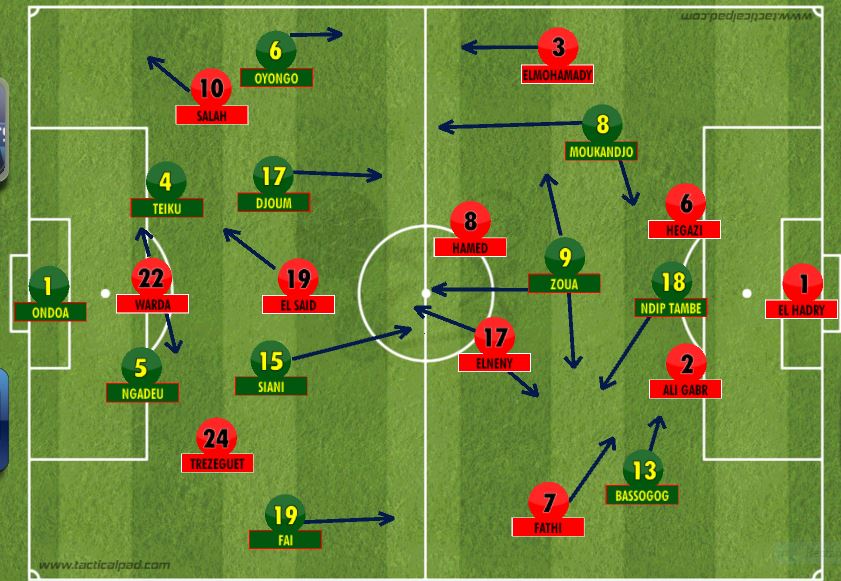
It’s time for the latest edition of the brand new series on Outside of the Boot, as we head to Egypt. As with almost every other rivalry in football, in fact in any sport, there is a heady mixture of geographic, social, and sporting history that defines a fixture. Oliver McManus delves into the rivalry of Al Ahly vs Zamalek.
I am reminded of a conversation I had the other day; a conversation between myself, my good man Nat Manser and Will Lewis, a conversation around one simple question, “what is the greatest rivalry in all of football?” For me, it was a simple answer, admittedly one that not many people in Britain would have initially thought of but in my opinion, it is Al-Ahly v Zamalek, also known as the ‘Cairo Derby’.
In a country such as Egypt, where segregation is existential in everyday life, football has a bizarre fashion of being able to unite fans of a team, throwing race, class, religion, all sorts aside before pitting two rivals against each other and watching it ignite in sheer passion and glory. To fully understand why this has become to be known as the biggest match in all of Africa’s footballing calendar, we must first get to grips with the history of both clubs, and this intimidating rivalry.

Al Ahly, nicknamed The Red Devils, were formed in 1907, becoming the first Egyptian-run club, in a time when the country was controlled in large parts by the United Kingdom and France. Fans clamoured behind the club, seeing it as a symbol of nationalism, against foreign occupation.
Zamalek, known as The White Knight, emerged on the footballing scene just four years later, in 1911. They were backed by a Belgian president with an aim of solidarity amongst fans, regardless of occupation or cultural differences.
With both clubs plying their trade in the Cairo International Stadium, and Ahly being seen as a nationalist, Muslim side, compared to Zamalek who are typically seen as a mixed, open club, a fierce rivalry was inevitable. And so it proved, although the first Likaa El Kemma (Meeting of the Best) took place in 1917, the real clash of the titans started in 1948 – coinciding with the formation of the Egyptian Premier League.
The match is one which spills far from the boundaries of Cairo, over the borders of Egypt and into much of the Middle East, where many millions watch the match with an eagerness unrivalled in all of world football. From their dawn of the leagues creation, the Cairo clubs have established an untouchable dynasty within Egyptian football.
Al-Ahly won the inaugural Premier League, and dominated much of the first half of the 20th Century – claiming a grand total of 37 titles since. Zamalek mounted their first title assault in the season of 1959-1960, claiming their first of 12 Championships, although they have finished runners-up on 32 occasions, in large part to their nearest rivals.
In the early days, the rivalry existed due to largely socio-economic circumstances. Zamalek were of the opinion that they were better than Al-Ahly, not in a footballing sense, but in a cultural and personal sense because, despite a revamp the club were still mainly for the upper echelons of society, the aristocrats and rich businessman – a fact they were always willing to flaunt in the face of the opposition.
Played in front of a 100,000 strong crowd at the ‘neutral’ Cairo International Stadium, matches are played in front of an atmosphere which, I am reliably informed, is unbeatable. Complete with deafening noise, blinding seas of colours and the occasional pyrotechnic display, it can be summed up with one word – electric. Only occasional, of course.
On a slightly more serious note, many of the matches through the decades have been overshadowed by violence, with fans from both clubs often channelling their aggression when results haven’t gone their way. The ‘ultras’ of both clubs have a pride and passion for their clubs and despite several fights and numerous injuries, the safety of match-goers was only really ensured after the country’s political revolution in 2011.
After a two year break, football returned in 2013, the fans of both clubs had a change in heart – after all, they had both fought in unity against the brutal regime of Dictator Hosni Mubarak – and violence has become less common. Whilst matches still have an atmosphere whereby anything could kick off at any minute, they have tended to be relatively constrained in recent times.
History has shown that whilst this footballing derby hasn’t always been packed with the world’s biggest stars – the Nigerian Emmanuel Amuneke, who played for his country in the 1994 World Cup, possibly being the biggest – it is a clash which has cultivated talent across the years and whilst not playing host to the world superstars, a good performance in the Egyptian Clasico can turn you into an overnight hero for your supporters. But, also, public enemy number one for the opposition – something Ayman Younes knows all too well.
Now a regular name in Egyptian media, their equivalent of Alan Shearer, he was a legend of Zamalek and recalls the hostility he faced from the Al-Ahly fans in chilling fashion, “I had a lot of problems with Ahly fans. In 1990 I found my BMW car on its side and they signed it ‘Ahly fans”. On one occasion, 5,000 of those very fans turned up outside his house; “Then there was the time they attacked me in my home. I had to phone the police. 5,000 Ahly fans came to my street and shouted against me, my wife and kids, throwing things at us.”
It must be said, one of my favourite revelations of the recent clashes would be the obscure story of Basem Ali, a 27 year-old Egyptian right back, who has been capped 12 times by Egypt. It was recently revealed that he had received a large fine and lengthy ban, after he had been found to have signed for Zamalek and Al-Ahly… at the same time!
Important Figures
The Cairo Derby has seen many players on the field, but there are some which will live in the memory longer than others, and these are my top three;
Hussein Hegazi
“Hussein He-who?”, I hear you ask, and rightly so, for he is a man not widely known outside of Africa, or your footballing anoraks, but he is a man who did more to change the shape of the game in Egypt than anyone else.
The first African footballer to play in England, he played for Dulwich Hamlet and Fulham, between 1911 and 1914, before returning to Egypt where he turned out for both The Red Devils and The White Knight, in two stints for each.
It’s not for his work on the pitch that he is perhaps best known, rather his managerial work – and one particular match which went down in infamy and which we will return to a little later on.
Hossam Ghaly
Some of you will recall this man from his days at Tottenham, or even Derby, where he played in the Premier League between 2006 and 2009. Al-Ahly fans, on the other hand, will remember him as one of the most naturally gifted players to set foot on the hallowed turf of the Cairo International Stadium.
Having had 3 spells at the club, he has accumulated 8 years on the senior books of his boyhood club, and 9 trophies with the team that he so passionately supports.
Hazem Emam
The word legend is often banded about candidly, I, myself, will admit to using it all too often but in the case of Hazem Emam, legend is a word which fails to do justice to the class of the man.
With over 170 games to Zamalek to his name, along with 86 caps for the Egypt national football team, he is widely regarded as one of the most talented players in all of Africa. His popularity is one which is so effervescent, he was one of few players to be openly lauded by the fans of the opposition. Having watched Hazem Emam, I would suggest that if you were to do the same, you get a coaster for your lower lip as you will be truly gobsmacked as to the technical quality he possesses.
Key games down the years
Not only has it bore witness to many a talented player, it has played host to some incredible matches over the year – here, again, are my favourite three;
2007 Egyptian Cup Final
Drama. Pure drama. The 2007 Egypt Cup Final was home to some of the most spectacular scenes you will ever see in world football. Zamalek had been humiliated the year before, running out 3-0 losers to Al-Ahly, and they hadn’t lifted the cup since 2002.
2007, by all accounts was supposed to be their year, they had a team with outstanding quality and took the lead on three occasions in the Cup Final and they looked odds-on to win it.
Al-Ahly cult hero, Mohamed Ahoutrika, had other ideas helping his club to come back and win, 4-3 in extra time – thanks to two moments of genius from himself – to pull of one of the all-time great comebacks.
1928 – Madraset El Fann Will Handasa
‘Madraset El Fann Will Handasa’, literally translates as ‘School of Arts and Engineering’ – a bizarre title with an equally bizarre back story. Hussein Hegazi, who I alluded to earlier, moved to Zamalek in 1928 and they had no team. That’s not me being hyperbolic – they genuinely had no team. So, not giving in, Hegazi, formed a side of students – from the local Engineering school, and they managed to beat a star-studded Al-Ahly side 1-0. Hegazi sparked a rivalry that will never, ever cease to amaze.
2015 Egypt Cup Final
There is not too much to be said about this particular rivalry, for it wasn’t the game itself that proved remarkable, more the overall trend. A shift in power appears to be coming to Cairo, Zamalek had won the previous two editions of the Egypt Cup – albeit not against Al-Ahly – and faced their rivals in the final last year.
A comfortable 2-0 win, sealed within the first half, could prove the turning point in the history of this derby. Zamalek look a force to be reckoned with and Al-Ahly certainly have a task on their hand if they are to keep up with them this season.
Rivalries are what makes football.
The unbridled passion, regardless of circumstance.
The unfaltering commitment, regardless of results.
The heartbreak, the adulation, the silent contemplation.
The life of a football fan is many things, but it is never dull.
PS: In the week that the Hillsborough verdicts were delivered, I would just like to take the moment to remember the 96 fans who tragically lost their lives, and their families.
Families who did nothing more than wave off their brothers, sister, fathers, mothers, sons and daughters and yet had to wait 27 years to find the truth and to have justice delivered.
When tragedy befalls us, we must unite in the search for what is right, the spirit of the 96 burns in our hurt and inspires us to be the best, every single day.
You’ll Never Walk Alone.
Written by Oliver McManus
- Syria: The path to World Cup qualification - July 8, 2020
- The story of South Africa’s topsy-turvy footballing journey - November 8, 2017
- Interview: Sunil Chhetri on his foreign stints, Bengaluru FC, and the rise of Indian football - October 24, 2017
























































